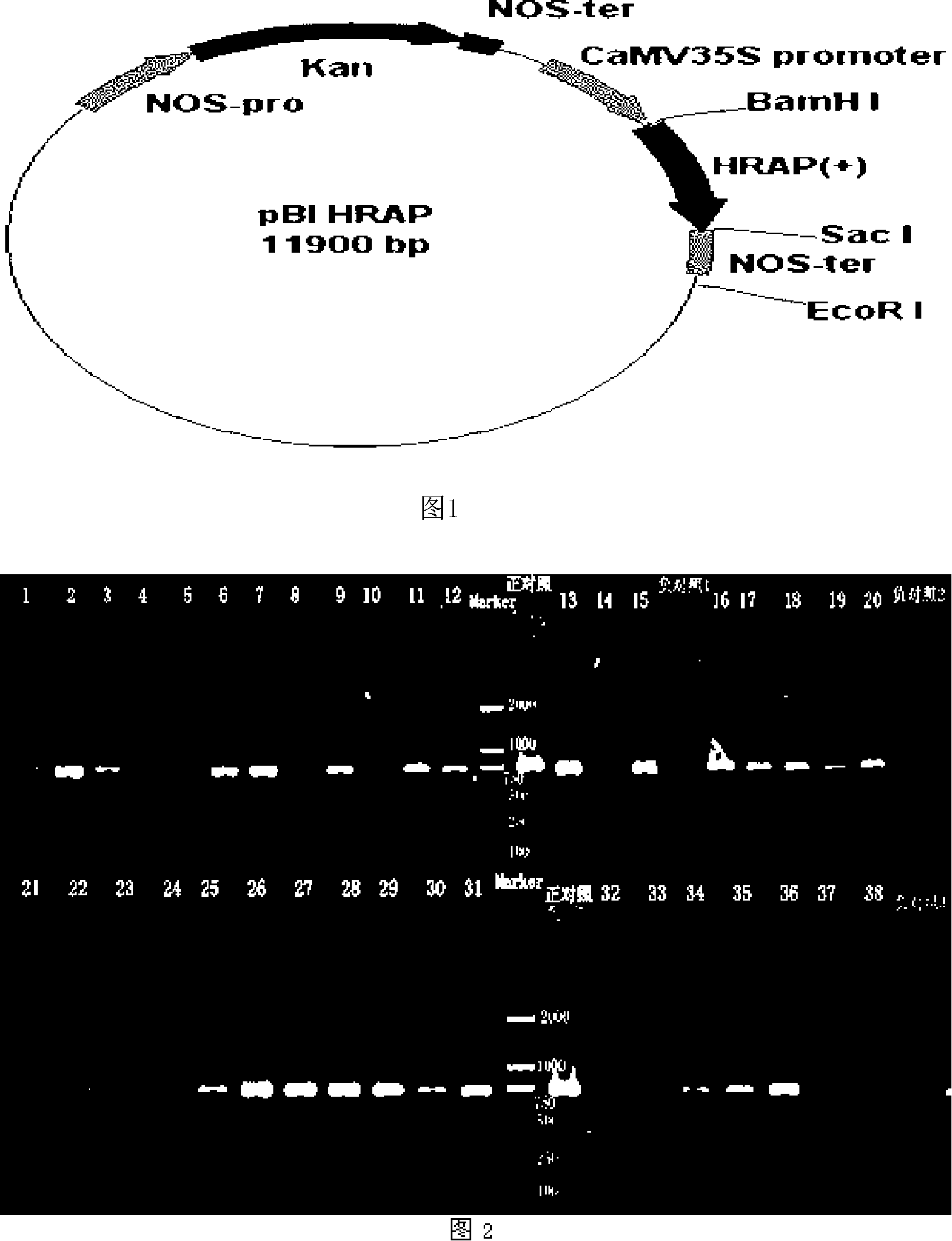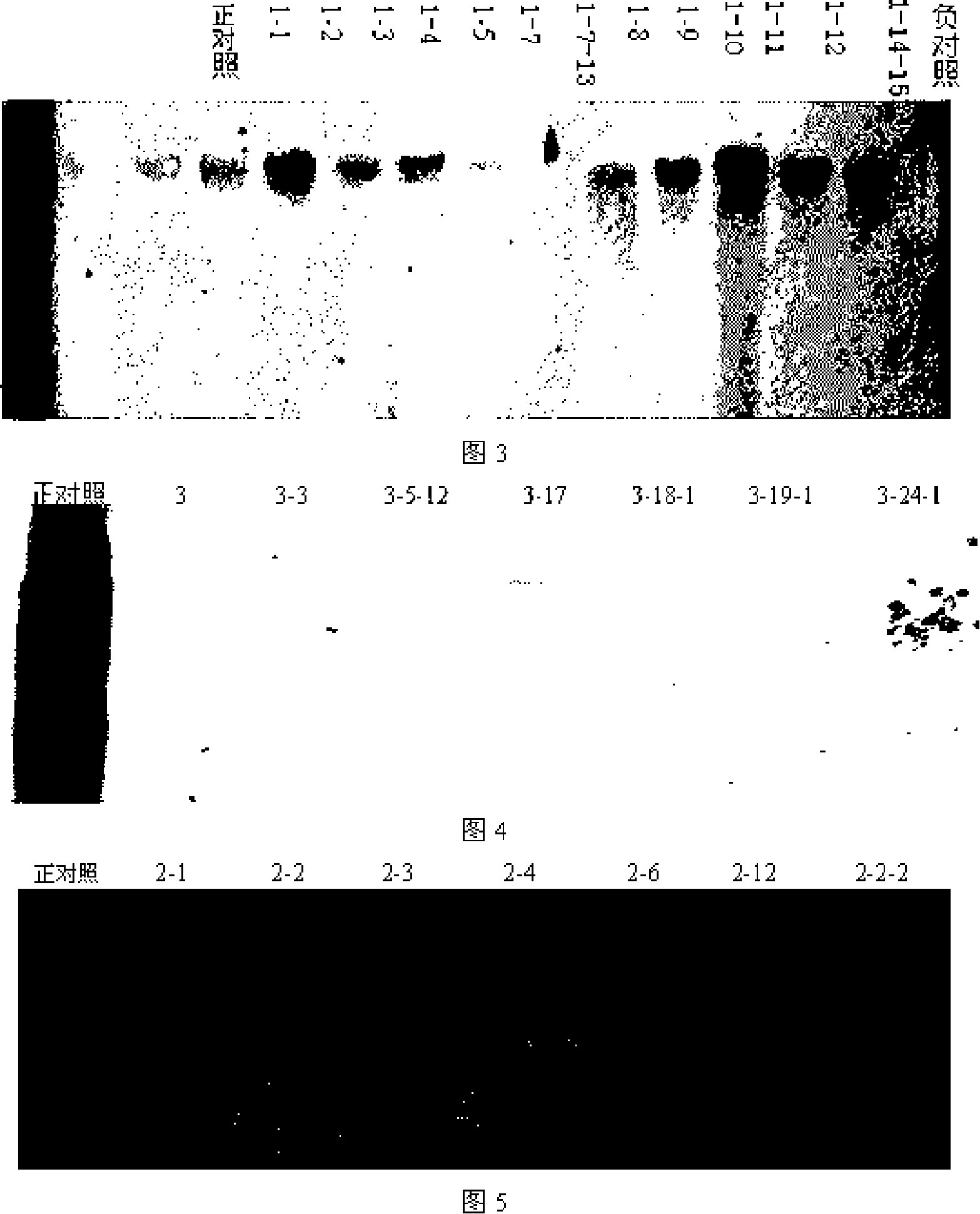Method for acquiring disease-resistance expression of agrobacterium-mediated potato transgenic hrap
An Agrobacterium-mediated, potato-based technology, applied in other methods of inserting foreign genetic materials, horticultural methods, genetic engineering, etc., can solve the problems of restricting production and processing capacity, easy loss of resistance, rapid mutation of pathogenic races, etc.
- Summary
- Abstract
- Description
- Claims
- Application Information
AI Technical Summary
Problems solved by technology
Method used
Image
Examples
Embodiment 1
[0108] 1. Transformation and cultivation of explants
[0109] (1) Bacterial solution preparation: Inoculate the Agrobacterium LBA4404 bacterial solution carrying the plasmid pBI hrap into the liquid LB medium supplemented with 100mg / L Kan, 100mg / L Sm and 100mg / L Rif, and culture at a moderate speed at 28°C on a shaker to OD 600 The value is 0.4, the Agrobacterium bacterium liquid is obtained, and it is set aside;
[0110] (2) Pre-cultivation: take the leaves of "Burbank" tissue culture seedlings that have been cultivated for 4 weeks and grow robustly, and cut them into 0.4cm 2 Inoculate the small pieces face down in the y2 medium composed of MS+2.0mg / L 6BA+0.2mg / L NAA+0.2mg / L 2,4D+16g / L sucrose+6g / L agar, at 22 Cultivate in dark for 2 days;
[0111] (3) Diffusion: the leaves of the pre-cultured "Burbank" tissue-cultured seedlings were inoculated into the bacterial liquid of Agrobacterium LBA4404 carrying the plasmid pBI hrap, and the leaves of the tissue-cultured seedlings ...
Embodiment 2
[0118] Embodiment 2: Transformation and cultivation of explants: the Agrobacterium LBA4404 bacterium fluid that will preserve, carrying plasmid pBI hrap is inoculated in the liquid LB culture medium that adds 100mg / L Kan, 100mg / L Sm and 100mg / L Rif, in Cultivate at medium speed at 28°C on a shaker until OD 600 The value is 0.5, and the Agrobacterium bacterial liquid is obtained for use; the leaves of the "Atlantic" tissue culture seedlings that have been cultivated for 3 weeks and grown vigorously are cut off the edge and cut into 0.5cm 2 Inoculate the small pieces face down in the y2 medium composed of MS+2.0mg / L 6BA+0.2mg / L NAA+0.2mg / L 2,4D+16g / L sucrose+6g / L agar, at 22 Cultivate in dark at ℃ for 2 days; inoculate the leaves of the tissue cultured seedlings into the bacterial solution of Agrobacterium LBA4404 carrying the plasmid pBI hrap, and make the leaves of the tissue cultured seedlings fully contact with the bacterial solution of Agrobacterium bacterium for 10 minutes...
Embodiment 3
[0119] Embodiment 3: Transformation and cultivation of explants: the Agrobacterium LBA4404 bacterium liquid that will preserve, carrying plasmid pBI hrap is inoculated in the liquid LB culture medium that adds 100mg / L Kan, 100mg / L Sm and 100mg / L Rif, in Cultivate at medium speed at 28°C on a shaker until OD 600 The value is 0.5, and the Agrobacterium bacterial liquid is obtained, and it is used for later use; the leaves of "Russet Burbank" potato tissue culture seedlings that have been cultivated for 4 weeks and grown robustly are cut off the edges and cut into 0.4cm 2 Inoculate the small piece of the small piece in y2 medium face down, and culture it in dark at 23°C for 2 days; the leaves of the tissue cultured seedlings were inoculated in the bacterial solution of Agrobacterium LBA4404 carrying the plasmid pBI hrap, and the leaves of the tissue cultured seedlings were mixed with Agrobacterium Fully contact with the solution for 20 minutes; take out the leaves of the tissue c...
PUM
 Login to View More
Login to View More Abstract
Description
Claims
Application Information
 Login to View More
Login to View More - R&D
- Intellectual Property
- Life Sciences
- Materials
- Tech Scout
- Unparalleled Data Quality
- Higher Quality Content
- 60% Fewer Hallucinations
Browse by: Latest US Patents, China's latest patents, Technical Efficacy Thesaurus, Application Domain, Technology Topic, Popular Technical Reports.
© 2025 PatSnap. All rights reserved.Legal|Privacy policy|Modern Slavery Act Transparency Statement|Sitemap|About US| Contact US: help@patsnap.com


